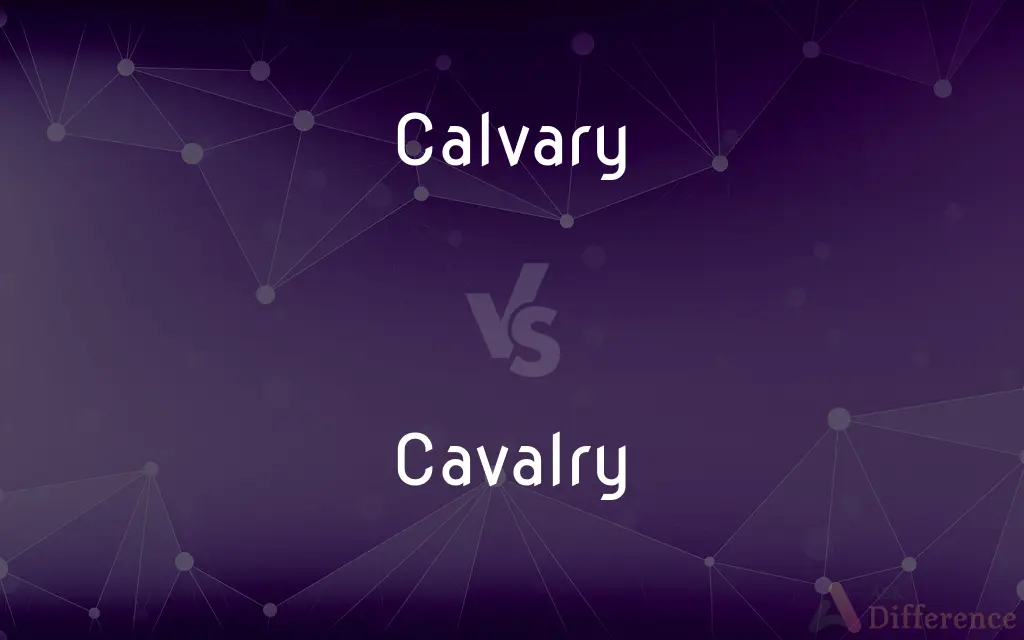Calvary vs. Cavalry — What's the Difference?
Edited by Tayyaba Rehman — By Urooj Arif — Updated on April 24, 2024
Calvary refers to the site of Jesus Christ's crucifixion, a significant religious symbol, whereas cavalry describes a military unit or troops mounted on horseback.

Difference Between Calvary and Cavalry
Table of Contents
ADVERTISEMENT
Key Differences
Calvary, often symbolized by a hill, is primarily associated with Christian theology as the place where Jesus was crucified. On the other hand, cavalry is a term used in military contexts to describe troops who fight on horseback, historically important in many armies.
The significance of Calvary is rooted in its spiritual and historical importance to Christians, symbolizing sacrifice and redemption. Whereas cavalry units have been crucial in battles for their speed and mobility, playing strategic roles in historical conflicts.
Art and literature frequently depict Calvary as a solemn, sacred place marked by crosses; it's a common motif in Christian iconography. In contrast, cavalry has been romanticized in historical novels and films, often portrayed as gallant and daring.
Visits to Calvary in religious pilgrimages emphasize reflection and reverence, highlighting its importance in Christian faith. Meanwhile, cavalry reenactments and exhibitions showcase military tactics and horsemanship, celebrated in various cultures.
While Calvary holds a place in religious ceremonies, particularly in reenactments of the Passion of Christ during Easter, cavalry is often featured in parades and historical commemorations, reflecting its enduring military heritage.
ADVERTISEMENT
Comparison Chart
Definition
The site of Jesus Christ’s crucifixion
Military troops trained to fight on horseback
Significance
Religious, symbolic of sacrifice and redemption
Military, significant for mobility in battle
Common Associations
Christianity, redemption, crucifixion
Military tactics, speed, historical battles
Depictions in Culture
Religious art, crucifix scenes
Films, novels, historical reenactments
Role in Society
Spiritual reflection, religious ceremonies
Military parades, reenactments, historical pride
Compare with Definitions
Calvary
The site of Jesus Christ’s crucifixion, a hill outside Jerusalem.
Pilgrims visit Calvary to honor the crucifixion.
Cavalry
Soldiers or warriors who fight mounted on horses.
The cavalry charged into battle at dawn.
Calvary
A sculpture or representation of the scene of Jesus Christ’s crucifixion.
The church displayed a new Calvary at the altar.
Cavalry
Used figuratively to describe a rescue or intervention by an arriving force.
The technical team acted as the cavalry, fixing the issue in the nick of time.
Calvary
Used metaphorically to represent an experience of intense suffering.
His struggle with illness was his own Calvary.
Cavalry
In modern terms, sometimes refers to units in armored vehicles.
The modern cavalry uses tanks instead of horses.
Calvary
A place or occasion of severe test or suffering.
The disaster area was like Calvary for the first responders.
Cavalry
Any swift, mobile military force.
The rapid response team is like the cavalry of the police force.
Calvary
Any experience that causes great distress or hardship.
Going through the divorce was a real Calvary for her.
Cavalry
A unit of an army made up of such soldiers.
He served in the 5th Cavalry during the war.
Calvary
Calvary, or Golgotha (Koinē Greek: Γολγοθᾶ[ς] Golgothâ[s], traditionally interpreted as reflecting Syriac: ܓܓܘܠܬܐ gāgūlṯā, as it were Hebrew gulgōleṯ "skull" (גולגולת); Arabic: جلجثة), was, according to the canonical Gospels, a site immediately outside Jerusalem's walls where Jesus was crucified.The Gospels use the Koine term Kraníon (Κρανίον) or Kraniou topos (Κρανίου τόπος) when testifying to the place outside Jerusalem where Jesus was crucified. E.g., Mark 15:22 (NRSV), "Then they brought Jesus to the place called Golgotha (which means: 'the place of a skull')." Kraníon is often translated as "Skull" in English, but more accurately means Cranium, the part of the skull enclosing the brain.
Cavalry
Historically, cavalry (from the French word cavalerie, itself derived from "cheval" meaning "horse") are soldiers or warriors who fight mounted on horseback. Cavalry were the most mobile of the combat arms, operating as light cavalry in the roles of reconnaissance, screening, and skirmishing in many armies, or as heavy cavalry for decisive shock attacks in other armies.
Calvary
The hill outside Jerusalem on which Christ was crucified.
Cavalry
(in the past) soldiers who fought on horseback
The cavalry charged up the hill
The army numbered around 100,000 cavalry
Calvary
A sculptured depiction of the Crucifixion.
Cavalry
Troops trained to fight on horseback.
Calvary
Calvary A great ordeal.
Cavalry
A highly mobile army unit using vehicular transport, such as light armor and helicopters.
Calvary
A life-size representation of the crucifixion of Jesus Christ on a piece of raised ground.
Cavalry
The military arm of service that fights while riding horses.
Calvary
A series of representations of Christ’s Passion in a church.
Cavalry
An individual unit of the cavalry arm of service.
Calvary
A type of monumental public Christian cross, sometimes encased in an open shrine.
Calvaries are typical of Galicia (Spain) and Portugal.
Cavalry
The branch of the military transported by fast light vehicles, also known as mechanized cavalry.
Calvary
A strenuous experience.
Cavalry
(figurative) Source of rescue, especially in an emergency.
Call in the cavalry
Calvary
The place where Christ was crucified, on a small hill outside of Jerusalem.
Cavalry
That part of military force which serves on horseback.
Calvary
A representation of the crucifixion, consisting of three crosses with the figures of Christ and the thieves, often as large as life, and sometimes surrounded by figures of other personages who were present at the crucifixion.
Cavalry
Troops trained to fight on horseback;
500 horse led the attack
Calvary
A cross, set upon three steps; - more properly called cross calvary.
Cavalry
A highly mobile army unit
Calvary
A hill near Jerusalem where Jesus was crucified
Calvary
Any experience that causes intense suffering
Common Curiosities
What was the historical importance of cavalry?
Historically, cavalry was important for its mobility and speed, allowing armies to execute swift attacks and strategic retreats in battle.
How are Calvary and cavalry often confused in speech?
The terms Calvary and cavalry are homophones in English, sounding similar but differing completely in meaning and usage.
What does Calvary symbolize in Christianity?
Calvary symbolizes the place of Jesus Christ's crucifixion, representing sacrifice and the redemption of humanity in Christian theology.
What kind of training does cavalry receive?
Cavalry training includes combat training, maneuvering mounted units (historically horses, now vehicles), and often, advanced reconnaissance skills.
Can "Calvary" be used in a non-religious context?
Yes, metaphorically, "Calvary" can describe any severe test or suffering someone experiences.
How is Calvary represented during Easter celebrations?
During Easter, Calvary is often represented in plays, processions, and reenactments of the Passion of Christ, emphasizing its spiritual significance.
Why is Calvary significant to pilgrimages?
Calvary is a key pilgrimage destination as it is the site of Jesus Christ's crucifixion, holding deep spiritual significance for Christians.
What are the roles of cavalry in modern military?
In modern militaries, cavalry units often use armored vehicles and are crucial for rapid response and strategic mobility.
How do depictions of Calvary influence Christian worship?
Depictions of Calvary in art and sculptures serve as focal points for worship and reflection, especially during religious ceremonies like Easter.
What does it mean when someone says they need the cavalry?
This phrase typically means someone is hoping for timely help or intervention in a difficult situation.
Is cavalry still relevant in today's military tactics?
Yes, modern cavalry units, equipped with advanced vehicles and technology, continue to play a crucial role in military tactics.
How is the cavalry used in non-combat situations?
In non-combat situations, cavalry units often participate in ceremonial roles, such as parades, or as part of peacekeeping forces.
Are there any famous literary works focusing on cavalry?
Yes, numerous historical novels and accounts focus on cavalry, such as those detailing the exploits of cavalry in American Civil War or in the Napoleonic Wars.
How do Calvary and cavalry compare in terms of cultural impact?
While Calvary has a profound religious and spiritual impact in Christian cultures, cavalry has a broad historical and military cultural significance.
What does the presence of a Calvary sculpture in a church signify?
A Calvary sculpture in a church signifies reverence for Christ's crucifixion and serves as a visual reminder of his sacrifice.
Share Your Discovery

Previous Comparison
Whoa vs. Woe
Next Comparison
People vs. PersonsAuthor Spotlight
Written by
Urooj ArifUrooj is a skilled content writer at Ask Difference, known for her exceptional ability to simplify complex topics into engaging and informative content. With a passion for research and a flair for clear, concise writing, she consistently delivers articles that resonate with our diverse audience.
Edited by
Tayyaba RehmanTayyaba Rehman is a distinguished writer, currently serving as a primary contributor to askdifference.com. As a researcher in semantics and etymology, Tayyaba's passion for the complexity of languages and their distinctions has found a perfect home on the platform. Tayyaba delves into the intricacies of language, distinguishing between commonly confused words and phrases, thereby providing clarity for readers worldwide.














































